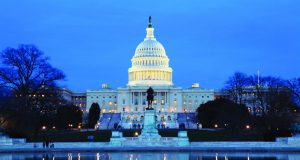Part III in our ongoing series Understanding Federal Appropriations
The COVID-19 pandemic has wreaked havoc on the local, regional, national and international stage. In the US, the federal response has focused on supporting individuals and institutions alike. Many businesses and non-profits need to understand how to navigate the complex process of accessing emergency or disaster aid.
In our latest installment of Understanding Federal Appropriations, we examine the disaster supplemental appropriations process and the federal accounts supplemented in the Coronavirus Aid, Relief, and Economic Security (CARES) Act (P.L. 116-123). The CARES Act demonstrates that even during uncertain and unprecedented times, the federal appropriations process remains the same and advocacy groups play an important role in directing resources to areas in need.
“Emergency” vs. “Major Disaster” Designation
The disaster declaration process begins when the President of the United States makes a formal “emergency” or “major disaster” declaration. An “emergency” differs from a “major disaster” in terms of its approach to public assistance and individual assistance. For example, the public assistance program under an “emergency” declaration only includes “emergency protective measures” and “debris removal”; whereas, “major disaster” declarations allow the federal government to rebuild public infrastructure, among other things. “Major disasters” are specifically applied to “any natural event” such as hurricanes, earthquakes, fires, etc.
On March 13, 2020, President Donald Trump declared a national “emergency” in response to the coronavirus (COVID-19) pandemic. However, he hinted that it may also qualify as a “major disaster.” In his March 13th letter to cabinet secretaries, he stated, “[…] I believe that the disaster is of such severity and magnitude nationwide that requests for a declaration of a major disaster as set forth in section 401(a) of the Stafford Act may be appropriate.”[1] A “major disaster” designation would allow the Federal Emergency Management Agency (FEMA) to provide additional federal assistance such as crisis counseling services, disaster legal services, disaster supplemental nutrition assistance, etc.[2]
FEMA’s emergency assistance limit is $5 million per emergency but this amount can be adjusted if the president determines that certain criteria are met. On March 13th, President Trump committed “up to $50 billion” towards FEMA to help states, territories, and localities contain the spread of COVID-19.[3] The president determined that: 1) continued emergency assistance is immediately required; 2) there is a continuing and immediate risk to lives, property, public health, and safety; and 3) necessary assistance will not otherwise be provided on a timely basis.[4]
FEMA’s Disaster Relief Fund
FEMA’s disaster relief fund (DRF) is included in the annual appropriations process, but the requested level does not pre-fund anticipated needs arising out of disasters that have yet to occur.[5] For the upcoming fiscal year (FY), the president’s FY 2021 budget requested $5.1 billion in funding in FEMA’s DRF to cover the costs of previously declared major disasters and catastrophic events. Emergency dollars are adjusted through supplemental appropriations requests and proposed amendments to the budget when a disaster occurs.
CARES Act
On March 25th, Congress passed the CARES Act, a $2.2 trillion supplemental appropriations package. Of the $2.2 trillion, $340 billion (Division B) will go towards disaster relief and public assistance. Division B includes $117 billion for hospitals and veterans’ health care; $11 billion for vaccines, therapeutics, diagnostics, and other preparedness needs; $4.3 billion for the Centers for Disease Control; $16 billion for the Strategic National Stockpile; and $45 billion for FEMA’s DRF, among other things. More than 80 percent of the total funding provided in Division B will go directly to state and local governments.[6]
Division A of the CARES Act consists of a number of new programs that provide financial relief to individuals and businesses, and initiatives that alleviate burdens on the health care and educational systems. The legislation includes immediate and direct cash payments, deferred tax collection, small business loans, expanded unemployment insurance, etc. It also includes initiatives such as expanded access to telehealth and student loan payment deferrals. For a section-by-section analysis of all the programs that have been included in the CARES Act, please click here.
Working with your Strategies 360 Federal Team
S360’s Washington D.C. office is well equipped to support the firm’s clients navigating the appropriations process. They can cut through red tape and direct team members to the right offices and staffers at each phase of the appropriations process.
If you have any questions about the appropriations process, please feel free to contact Andy Winer (andyw@strategies360.com) or Serena Li (serenal@strategies360.com).
___________________________________________________________________________________________________
[1] https://www.whitehouse.gov/briefings-statements/letter-president-donald-j-trump-emergency-determination-stafford-act/
[2] https://www.fema.gov/disaster-declaration-process
[3] https://www.whitehouse.gov/briefings-statements/remarks-president-trump-vice-president-pence-members-coronavirus-task-force-press-conference-3/
[4] https://uscode.house.gov/view.xhtml?req=granuleid:USC-prelim-title42-section5193&num=0&edition=prelim
[5] https://www.whitehouse.gov/wp-content/uploads/2020/02/Sequestration_Preview_2-10-20.pdf
[6] https://www.appropriations.senate.gov/news/senate-passes-critical-bipartisan-legislation-to-address-national-coronavirus-crisis
